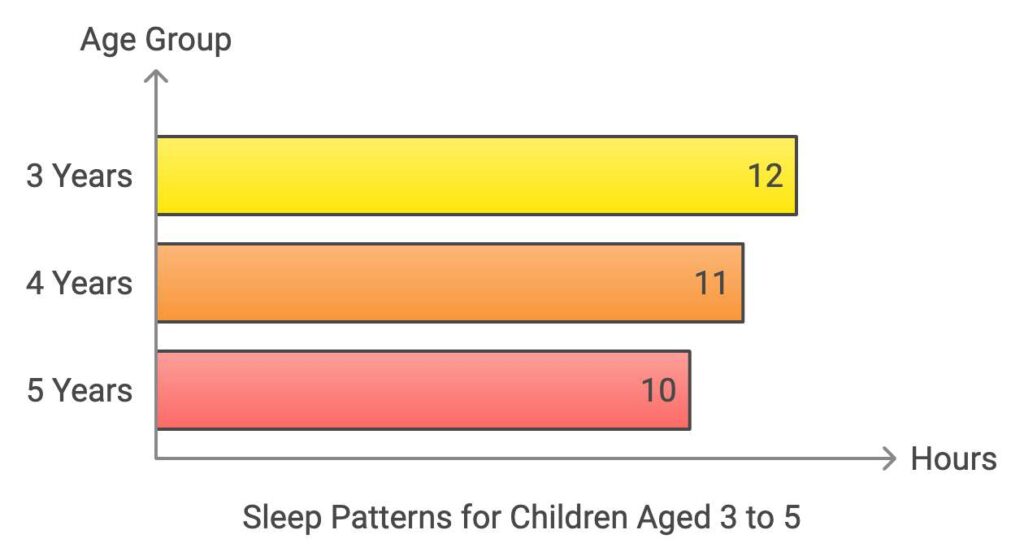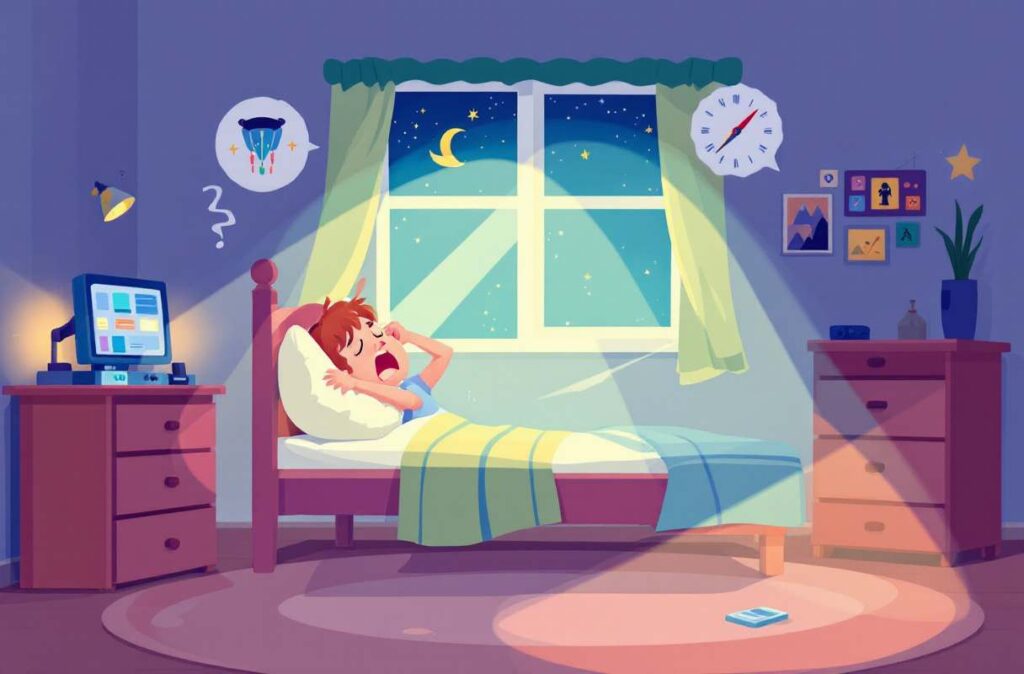Ever wonder why your preschooler is full of energy one minute and ready to snooze the next? Understanding their sleep habits might be the key to happier days and more peaceful nights for your whole family.
Let’s delve into the world of preschooler sleep and discover how to help your little one drift off into sweet dreams.
Understanding Preschooler Sleep Habits
Preschoolers need their shut-eye just as much as adults do—or maybe even more! Tuning into how these little humans sleep can help parents and caregivers craft a cozy nighttime mix that gets everyone dreaming sweetly.

Why Good Sleep Matters for Preschoolers
Making sure preschoolers have solid sleep routines is kind of a big deal. Enough snooze time helps them grow, think straight, and keep their cool. Kids who hit the sack on time find it easier to learn, play nice with others, and bounce out of bed in the morning. Studies say catching those Z’s can sharpen memory and boost problem-solving skills in the youngins.
What Preschooler Sleep Looks Like
Preschoolers generally clock 10 to 13 hours of sleep daily, which could include a nap — you know, for those mid-day recharges. Each child is different, though; bedtime routines and morning rituals all play a part in sleep quality. Peek at the table below for a typical snooze schedule.
| Age Group | Suggested Sleep Time (hours) | Usual Sleep Patterns |
|---|---|---|
| 3 years | 10 – 13 | Often still enjoy that daytime nap |
| 4 years | 10 – 12 | Might say goodbye to naps, but downtime helps |
| 5 years | 10 – 12 | Mostly nap-free, though occasional siestas are welcome |
Curious about sleep around other ages? Check out our guides on newborn sleep patterns and toddler sleep regression.

What Can Mess with a Preschooler’s Sleep?
Plenty can interrupt a preschooler’s beauty sleep. Here are some of those dream stealers:
- Setting: Too much noise, blinding light, or an uncomfy bedroom can mess with their snooze.
- Routine: A chill bedtime routine signals it’s time for dreamland.
- Health: Things like allergies or asthma, or even heartburn, can make a kid toss and turn.
- Feelings: Changes at home or anxieties—the little stuff can weigh big on a young mind.
Grasping what shakes up sleep lets parents fix up sleepy-time routines better. Want more tips? See what we’ve got on screen time and sleep and teenage sleep deprivation.
Setting the Stage for Sleep
Getting your preschoolers to drift off to dreamland isn’t just about putting them in bed and hoping for the best. It’s about crafting the right vibe for sleep and turning bedtime routines into cherished moments.
Creating a Consistent Bedtime Routine
Kids and routines go together like peanut butter and jelly. A bedtime routine means little ones know it’s time to kick back and relax. We’re talking about chill activities like storytime, splashing in a warm bath, or that old favorite, soft lullabies. This soothing sequence doesn’t just help with falling asleep but adds a sprinkle of calm predictability to their day.
“Kids and routines go together like peanut butter and jelly. A bedtime routine means little ones know it’s time to kick back and relax.”
Check out this nifty bedtime plan:
| Time | Activity |
|---|---|
| 7:00 PM | Dinner |
| 7:30 PM | Bath time |
| 7:45 PM | Storytime |
| 8:00 PM | Bedtime |
A routine like this can be a game-changer, making bedtime smoother than a lullaby’s tune. Plus, if you’re curious about handling sleep during those tricky times, snoop around our toddler sleep regression insights.
Establishing a Calming Sleep Environment
Think of your child’s room as a sleepy-time sanctuary. The darker and quieter, the better. Consider putting up those blackout curtains to keep sneaky sunlight at bay or crank up a white noise machine to hush the outside world buzzing by.
“Think of your child’s room as a sleepy-time sanctuary. The darker and quieter, the better.”
Here’s how to create that perfect nest:
| Element | Recommendation |
|---|---|
| Lighting | Dim or soft lighting before bed |
| Noise | White noise machines or soft tunes are your friends |
| Temperature | Keep it cool, somewhere between 68°F and 72°F |
When the bedroom feels snug and safe, kids snuggle into sleep faster. And if dealing with screen glare is a worry, we’ve got the lowdown on screen time and sleep in our other articles.
Encouraging Independent Sleep Skills
Little sleep champs need to learn how to snooze solo. It’s about getting them comfy with drifting off without a parent standing guard.
Here’s the how-to for nighttime independence:
- Give them a bedtime buddy, like their favorite bear or a fuzzy blanket.
- Let them play a role in their sleep-prep, like picking tonight’s tale or buttoning up their jammies.
- Use a sneaky departure strategy; start by sitting nearby and then slowly increase the distance over time.
Handing your kiddo the reins on their own sleeping skills boosts their ability to nod off and stay asleep. Plus, for a peek into how sleep differs across ages, we’ve got details in our newborn sleep patterns piece.
With these pointers, you’re setting the groundwork for your child’s dreamy and peaceful bedtime experience. Happy snoozing!

Addressing Common Sleep Challenges
Dealing with preschooler sleep habits can be a real head-scratcher for parents. Kids sometimes seem on a mission to disrupt their own sleep and yours too. Let’s dive into some frequent hiccups and how to smooth them out.
Night Wakings and Resisting Bedtime
If junior keeps popping up in the middle of the night or fights bedtime like a superhero on a mission, you’re not alone. They might be hungry, scared, or even a bit uncomfortable in their tiny beds.
How to Make Nights Peaceful:
- Stick to a Routine: Craft a nightly ritual that’s as cozy as grandma’s hugs. A predictable wind-down can work wonders.
- Snuggle Buddies: A beloved teddy or blankie can do wonders at night—it’s like adding an extra layer of security.
- Reassurance Is Key: When the little one digs in their heels at bedtime, soothing words and a calming presence remind them there’s nothing to fear.
| Why They Wake Up | What to Try |
|---|---|
| Hungry Tummy | Offer a healthy bedtime snack. |
| Fright | A night light and a cuddly friend can be reassuring. |
| Noise or Comfort Issues | Double-check for anything that’s messing with their beauty rest. |
Handling Nightmares and Night Terrors
Both nightmares and night terrors can pull a parent’s heartstrings. Nightmares are like bad movies our kids experience, while night terrors are more like scary sleepwalking with no recall afterward.
Tips for Calming Sleep Troubles:
- Fear Chats: Let them spill the beans on their nightmares and remind them of their safety.
- Chill Out Routines: Show them how to relax with deep breaths or stretching to ease those bedtime jitters.
- Safe Zone: Create a soothing bedroom without creepy shadows or unsettling noises.
| Chills and Thrills | What to Do |
|---|---|
| Nightmares | Share dreams and weave in calming tales at bedtime. |
| Night Terrors | Remain calm, ensure safety, and wait for the storm to pass. |
Managing Transition from Naptime to Quiet Time
Kids grow up so fast, and as they age, they might need less shut-eye during the day. This transition can be a bit tricky, impacting their nighttime snooze if not handled right.
Making the Shift Painless:
- Ease Into It: Slowly cut down on daytime dozing instead of a sudden stop—baby steps help.
- Quiet Playtime: Swap naps for chill activities like reading or puzzles to keep them entertained but not exhausted.
- Watch Their Cues: Keep a keen eye on their mood to judge if they still need those naps or just quiet time.
| Age Group | Suggested Nap Duration |
|---|---|
| 2-3 year-olds | About 1 to 2 hours |
| 4-5 year-olds | 30 minutes to an hour |
Understanding these sleep challenges and finding the best strategies will help usher in peaceful nights for your little ones. Curious about more tips? Check out our articles on toddler sleep regression and sleep tips for your 30s.
Promoting Healthy Sleep Habits
Getting those little sleep monsters, aka preschoolers, to snooze soundly might seem like a big task, but it’s a total game-changer for their growth. Below, you’ll find some handy tips to transform them into sleepyhead champions.
Balancing Activity and Rest
Kids need their fun-time frenzy to burn off that boundless energy, no doubt about it. But pairing it with some chill moments is just as important to get them prepped for dreamland.
Making a daily game plan with both high-energy play and chill activities like book time or puzzles helps strike that magic balance. Here’s a sample day that might help your kiddo catch the best Z’s:
| Time of Day | Activity Type | Suggested Duration |
|---|---|---|
| Morning | High-Energy Play | 1 – 2 hours |
| Midday | Quiet Time | 1 hour |
| Afternoon | Outdoor Adventure | 1 – 2 hours |
| Evening | Wind-Down Routine | 30 minutes |
Limiting Screens Before Bedtime
Gadgets might be fun, but they’re terrible bedtime buddies. The blue light from them acts like a sleep-wrecker, messing with natural cycles. Shutting down screens at least an hour before bed helps kids switch gears to snooze mode.
Here are some easy-peasy screen rules:
| Recommendation | Detail |
|---|---|
| Limit Screen Use | No screens one hour before lights out |
| Non-Screen Fun | Opt for things like storytelling, crafts |
| Screen-Free Zones | Keep the gadgets out of sleeping areas |
Check out our piece on screen time and sleep for more insights on this topic.
Providing Nutritious Meals and Snacks
What kids eat matters for more than just being healthy; it helps them sleep better, too. A diet filled with good stuff like whole grains, fruits, veggies, and proteins can make a big difference.
Here’s a quick guide to what meals could look like:
| Meal Time | Suggested Foods |
|---|---|
| Breakfast | Cereal with whole grains, fruit, and yogurt |
| Lunch | Lean protein (like chicken or fish) with veggies |
| Dinner | Similar to lunch with added fiber and proteins |
| Snacks | Fresh fruit, cheese, or whole grain crackers |
Stick to routine meals and snacks to keep those energy levels steady and pave the way for good sleep. For more on tweaking sleep times as kiddos grow, have a peek at our article about adjusting sleep schedules.
By mixing in active play, getting savvy with screen rules, and dishing up nourishing meals, you’ll set preschoolers on a path for sweet slumbers and healthier snooze habits.

Collaborating with Caregivers and Pros
Getting those preschoolers to catch some quality shut-eye isn’t just on mom and dad’s shoulders—caregivers and the pros have a role to play too. Teamwork makes the dream work when it comes to creating an environment where kids get the rest they need.
Chatting About Sleep with Caregivers
Having a heart-to-heart about a child’s sleep needs is a must. Folks should fill in caregivers on their little one’s sleep patterns, routines, and any bumps in the night they’re dealing with. Everyone being on the same page means smoother sailin’ at bedtime and during naps.
Here’s a handy-dandy chart to share with caregivers:
| Sleep Stuff | What’s Happening |
|---|---|
| Average Z’s | 10 to 13 hours, including naps |
| Pre-Sleep Rituals | Things we do before lights out |
| Cozy Sleep Setup | Dark, quiet, and snug |
| Usual Sleep Hiccups | Night owls, bedtime battles |
This cheat sheet helps the folks watching over the kiddos keep things consistent, which is super-duper for good sleep vibes.
Getting a Hand from the Health Pros
If sleep drama sticks around like gum on a shoe, it’s worth asking the docs. Pediatricians and sleep whizzes can dish out handy tips for tackling sleep habits or dealing with specific hiccups like fear of the dark or sleep hulks.
Some questions to toss their way might be:
- What’s the scoop on preschooler sleep needs?
- How do I tackle my sleepyhead’s bedtime battles?
- Could there be any health stuff messing with sleep?
Talking it out lays the groundwork for smart strategies that fit the kid’s unique sleep groove.
Putting Together a Sleep Dream Team
Rounding up a posse that includes family, caregivers, and health pros can keep the good sleep train chuggin’. Regular check-ins keep everyone in the loop on how the little one’s snoozin’ and dozin’.
Bringing different perspectives together ensures that the child’s sleep is fine-tuned. Plus, having this backup squad gives parents a little pep in their step as they tackle any sleep woes.
For more sleep tips, why not check out pieces on newborn sleep routines, toddler night wakings, or the lowdown on screens and sleep?
Conclusion
Navigating the sleep patterns of preschoolers can feel like a journey, but with the right strategies, you can make bedtime a breeze. By creating consistent routines, establishing a calming sleep environment, and addressing common sleep challenges, you’re setting your child up for restful nights and bright mornings. Collaborating with caregivers and professionals ensures that everyone is on the same page, making sleep success a team effort. Embrace these tips, and watch your preschooler thrive with the energy and joy that come from a good night’s sleep.
FAQs
- Why is good sleep important for preschoolers?
Good sleep is crucial for preschoolers’ growth, learning, and emotional well-being. It helps them think clearly, behave better, and improves their overall health. - How many hours should my preschooler sleep each day?
Preschoolers typically need 10 to 13 hours of sleep daily, which may include a daytime nap, depending on their age and individual needs. - What factors can disrupt my child’s sleep?
Disruptions can include noise, light, uncomfortable bedroom settings, inconsistent routines, health issues like allergies or asthma, and emotional stress or anxiety. - How can I create a calming bedtime routine?
Establish a consistent routine with calming activities like a warm bath, reading a story, or soft lullabies to signal it’s time for sleep. - What should I do if my child resists bedtime or wakes up at night?
Maintain a soothing routine, provide comfort with a favorite toy or blanket, reassure them if they’re scared, and check for any discomfort or needs like hunger.
Additional Resources
- American Academy of Pediatrics: Healthy Sleep Habits
- National Sleep Foundation: Children and Sleep








